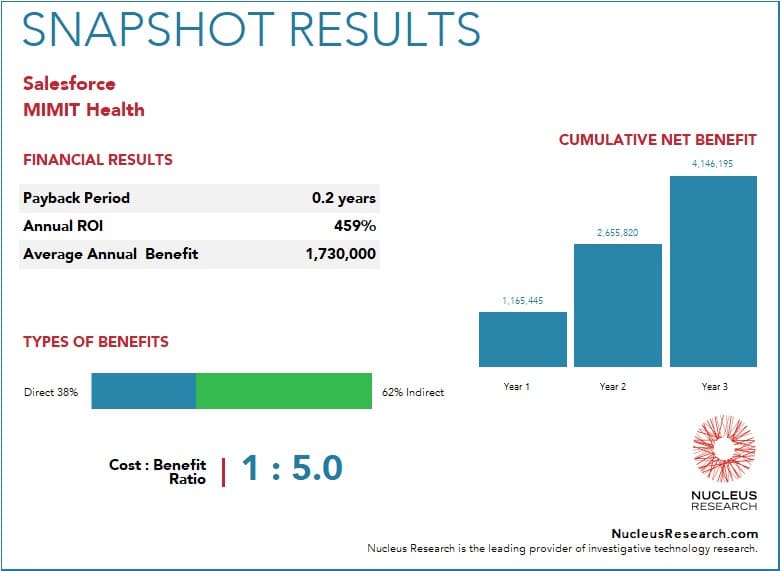With increasing financial pressures, healthcare organizations worldwide are looking for new ways to reduce costs and increase revenue.
Investments in the right software and related services can play a significant role in offsetting some of this financial pressure.
Whether your healthcare organization has already adopted Salesforce Health Cloud or plans to adopt Health Cloud, you may be more focused than ever on applications of the platform that produce quantifiable financial benefits.

Measuring financial benefit
A standard measure of financial benefit is the return on investment, or ROI.
If you have all the correct data, you can measure the return on your CRM investment using the following formula:
ROI percentage = (the return from an investment minus the cost of the investment) divided by the cost of investment times 100.
For example, if the financial return on a Health Cloud investment over a specified period was $500,000 and the cost of software and services was $200,000 over the same period, the ROI percentage calculation is:
($500,000 – $200,000) / $500,000 x 100 = 150%
In an exceptional example of a positive return on investment, a 2020 Nucleus Research case study revealed that MIMIT Health recognized a 459% annual ROI on its Salesforce Health Cloud implementation.

The importance of proper implementations for positive ROI
Salesforce Health Cloud falls under the Customer Relationship Management (CRM) category. “Patient Relationship Management” is a frequent adaptation of the term in the healthcare industry.
It’s important to remember that, as a software platform, CRM does not accomplish anything on its own. Only detailed planning, proper implementation, and ongoing user training will produce desired returns.
Because the right processes and resources aren’t always in place, CRM implementations across industries have a history of mixed results.
On the one hand, implementations can be highly successful and produce positive financial results that no one anticipated.
On the other hand, some implementations result in a negative return on investment.
What’s the difference maker? Maximizing the financial return on projects supported by Health Cloud requires, at a minimum:
- Prioritizing and defining the requirements that the software will address
- A well-executed implementation by an experienced team
- An ongoing training program
Benefiting financially from Health Cloud over the long term involves asking questions like, “If we add this functionality, how will it make us more operationally efficient, improve relationships with our patients, or help us acquire more patients?”
It also requires the appropriate levels of experience and expertise from business analysts and implementation specialists.
Factors that translate to economic benefits
An ROI on a software and services investment combines increased profits and cost savings.
Profits: Two easily measurable components of increased profits are the increased retention rate of existing patients and the acquisition rate of new patients.
Cost Savings: The most measurable reduced costs are staff time savings. For some healthcare organizations, the primary financial benefit may be cost savings.
Here are examples of these two and others.
Retain existing patients
One of the most frustrating things for consumers of any service, including patients, is a perception that “the left hand doesn’t know what the right hand is doing.” As consumers, patients are looking for a consistent customer experience.
Having satisfied and engaged patients is essential for healthcare organizations to retain those patients. Salesforce Health Cloud can contribute to patient retention on both the clinical and operational sides.
The clinical side: Health Cloud can help streamline care with the proper implementation of Care Plans.
The operational side: Heath Cloud can support patient retention in several ways, including timely and relevant communications using a patient’s preferred channel (phone, email, SMS). Targeted patient education email campaigns help with retention and reduce costs, such as those associated with unnecessary ED visits.
Acquire new patients
Acquiring new patients can be done from multiple sources, including word of mouth, outreach, and inbound marketing efforts.
As in any industry, getting a new customer usually involves a logical progression, such as AIDA (attention, interest, desire, action). In our digital world, marketing automation software facilitates progressions like AIDA.
The marketing automation functionality of Health Cloud allows for converting website visitors to prospective patients and then nurturing those prospects with email sequences that contain valuable information targeted to each prospective patient’s interests.
When an organization knows a patient’s LTV, the financial value of acquiring more new patients is measurable.
The calculation for patient LTV is revenue per visit times the number of annual visits times the number of years with your health system or practice.
Streamline manual processes
On the operational side, healthcare organizations want to do more with the same number of people or fewer people.
Health Cloud reduces the time it takes to accomplish specific tasks through automation. One example is referral intake processing. Another is using intelligent document automation to manage patient and member forms all in one place — from intake through processing.
If it once took a person-hour to accomplish a set of tasks manually, and now it takes 15 minutes, that’s a measurable financial benefit.
Reduce data errors
Something as simple as data validation rules, which are easy to set up in Salesforce Health Cloud, can reduce or eliminate a host of common data errors.
Specific data errors can delay the collection of payments from patients and insurers.
If costs related to past data errors have been measured, the associated cost reduction from reducing or eliminating specific errors with Health Cloud is also measurable.
Avoid financial penalties
Provider directory errors such as incorrect addresses, phone numbers, and insurance coverages can be subject to CMS fines — as much as $25,000 per Medicare beneficiary.
Healthcare organizations that have incurred the cost of these fines have been investing in better provider directory technologies. For example, Health Cloud is used by some Clinically Integrated Networks to house a more up-to-date and accurate directory.
Use reporting and analytics to make better financial decisions
Once your organization has collected enough data, specific reports can become eye-openers from a financial perspective.
For example, a report may reveal that a specific marketing campaign yielded no measurable results, but a different campaign yielded positive results. In that case, budgetary dollars can be reallocated from a poor-performing campaign to a better one.
Another example is using analytics to identify bottlenecks in the new patient acquisition process. If the numbers of prospective patients from marketing efforts are high, but few are becoming patients, more effort may need to be applied to engaging prospective patients.
While we have attempted to address the most easily measurable financial benefits of implementing Salesforce Health Cloud, there are often intangibles, such as reduced stress on staff, that come into play.
As with much enterprise software, proper planning and execution will result in the highest return on investment.
J2 Interactive is an award-winning software development and IT consulting firm that specializes in customized solutions for healthcare and life sciences.



